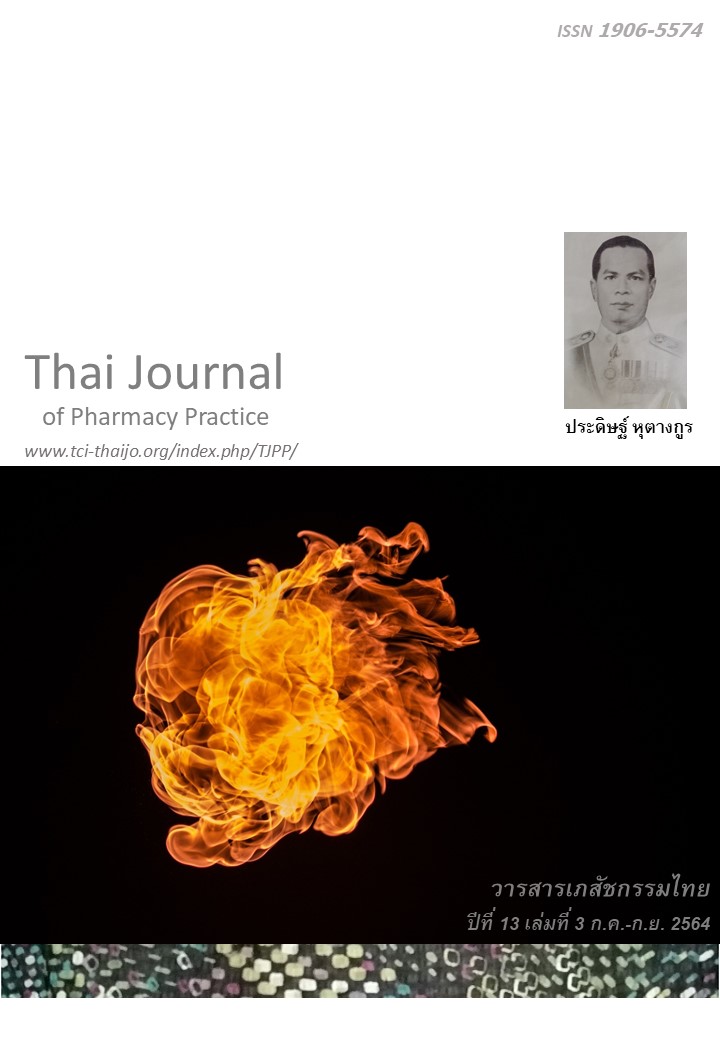ผลของการให้บริบาลทางเภสัชกรรมโดยเภสัชกรต่อการกลับมารักษาซ้ำ ในโรงพยาบาลภายใน 30 วันที่เกี่ยวเนื่องกับการใช้ยาในผู้สูงอายุ
Main Article Content
บทคัดย่อ
วัตถุประสงค์: เพื่อเปรียบเทียบผลของการให้บริบาลทางเภสัชกรรมโดยเภสัชกรต่ออัตราการกลับมารักษาซ้ำในโรงพยาบาลที่เกี่ยวเนื่องกับยาในผู้สูงอายุภายในระยะเวลา 30 วันหลังจำหน่าย วิธีการ: รูปแบบการวิจัยเป็นการศึกษาเชิงทดลองแบบสุ่มและมีกลุ่มควบคุมแบบปกปิดทางเดียว กลุ่มตัวอย่าง คือ ผู้ป่วยสูงอายุที่เข้ารับการรักษาตัว ณ หอผู้ป่วย อายุรกรรม โรงพยาบาลพนัสนิคม ที่ผ่านเกณฑ์การคัดเข้าร่วมการศึกษาจำนวน 192 คน ตัวอย่างได้รับการสุ่มแบบบล็อกแบ่งออกเป็นสองกลุ่ม ได้แก่ 1) กลุ่มศึกษา (กลุ่มผู้ป่วยที่ได้รับการบริบาลทางเภสัชกรรมโดยเภสัชกรร่วมกับบริการตามมาตรฐานของโรงพยาบาล) และ 2 ) กลุ่มควบคุม (กลุ่มผู้ป่วยที่ได้รับบริการตามมาตรฐานของโรงพยาบาล) ทั้งสองกลุ่มถูกติดตามตั้งแต่วันแรกรับ ณ หอผู้ป่วยจนสิ้นสุดการศึกษาที่ 30 วันหลังจำหน่าย การประะเมินผลลัพธ์ทำโดยจำแนกตามสาเหตุของการกลับเข้ารับการรักษาซ้ำที่เกี่ยวเนื่องกับยาภายใน 30 วัน และเปรียบเทียบผลระหว่างกลุ่ม ผลการวิจัย: เมื่อสิ้นสุดการวิจัยพบกลุ่มตัวอย่างรวมทั้งสิ้น 173 คน อยู่ในกลุ่มศึกษาและกลุ่มควบคุม 87และ 86 คน ตามลำดับ ผลจากการศึกษาพบอัตราการกลับมารักษาซ้ำในโรงพยาบาลที่เกี่ยวเนื่องกับยาภายในระยะเวลา 30 วันหลังจำหน่ายในกลุ่มศึกษา ร้อยละ 5.75 น้อยกว่ากลุ่มควบคุม พบร้อยละ 23.26 อย่างมีนัยสำคัญทางสถิติ (P<0.001) สรุป: การให้การบริบาลทางเภสัชกรรมโดยเภสัชกรร่วมกับบริการมาตรฐานของโรงพยาบาลสามารถลดอัตราการกลับมารักษาซ้ำในโรงพยาบาลด้วยสาเหตุที่เกี่ยวเนื่องกับยาภายใน 30 วันหลังจำหน่ายในกลุ่มผู้สูงอายุได้อย่างมีนัยสำคัญทางสถิติ
Article Details
ผลการวิจัยและความคิดเห็นที่ปรากฏในบทความถือเป็นความคิดเห็นและอยู่ในความรับผิดชอบของผู้นิพนธ์ มิใช่ความเห็นหรือความรับผิดชอบของกองบรรณาธิการ หรือคณะเภสัชศาสตร์ มหาวิทยาลัยสงขลานครินทร์ ทั้งนี้ไม่รวมความผิดพลาดอันเกิดจากการพิมพ์ บทความที่ได้รับการเผยแพร่โดยวารสารเภสัชกรรมไทยถือเป็นสิทธิ์ของวารสารฯ
เอกสารอ้างอิง
Renaudin P, Boyer L, Esteve MA, Bertault PP, Auquier P, Honore S. Do pharmacist-led medication reviews in hospitals help reduce hospital readmissions? A systematic review and meta-analysis. Br J Clin Pharmacol. 2016; 82: 1662-73.
Halfon P, Eggli Y, van Melle G, Chevalier J, Wasserfallen JB, Burnand B. Measuring potentially avoidable hospital readmissions. Clin Epidemiol. 2002; 55: 573-87.
Nursing Division Ministry of Public Health. Nursing quality Indicators [online]. 2018 [cited May 10, 2020]. Available from: www.nursing.go.th/?page_id=2489.
Hallgren J, Aslan AKD. Risk factors for hospital readmission among Swedish older adults. Eur Geriatr Med. 2018; 9: 603-11.
Khera R, Wang Y, Nasir K, Lin Z, Krumholz HM. Evaluation of 30-day hospital readmission and mortality rates using regression-discontinuity framework. JACC Cardio Oncol. 2019; 74: 219-31.
Lin K-P, Chen P-C, Huang L-Y, Mao H-C, Chan D-CD. Predicting inpatient readmission and outpatient admission in elderly: A population-based cohort study. Medicine. 2016; 95: 3484-99.
Ridgeway G, Nørgaard M, Rasmussen TB, Finkle WD, Pedersen L, Bøtker HE, et al. Benchmarking Danish hospitals on mortality and readmission rates after cardiovascular admission. Clin Epidemiol. 2019; 11: 67-80.
Chirapongsathorn S, Poovorawan K, Soonthornwo rasiri N, Pan-ngum W, Phaosawasdi K, Treeprasert suk S. Thirty-day readmission and cost analysis in patients with cirrhosis: a nationwide population-based data. Hepatol Commun. 2020; 4: 453-60.
Jenghua K, Jedsadayanmata A. Rate and predictors of early readmission among Thai patients with heart failure. J Med Assoc Thai. 2011; 94: 782-8.
Thamthajaree J. Efficiency of resource use in the health insurance scheme. Journal of Health Systems Research 2010; 4: 497-503.
Gillespie U, Alassaad A, Hammarlund-Udenaes M, Morlin C, Henrohn D, Bertilsson M, et al. Effects of pharmacists' interventions on appropriateness of prescribing and evaluation of the instruments' (MAI, STOPP and STARTs') ability to predict hospitali zation analyses from a randomized controlled trial. PLoS One. 2013; 8: 1-7.
Koehler BE, Richter KM, Youngblood L, Cohen BA, Prengler ID, Cheng D, et al. Reduction of 30-day post-discharge hospital readmission or emergency department (ED) visit rates in high-risk elderly medical patients through delivery of a targeted care bundle. Am J Hosp Med. 2009; 4: 211-8.
Schnipper JL, Kirwin JL, Cotugno MC, Wahlstrom SA, Brown BA, Tarvin E, et al. Role of pharmacist counseling in preventing adverse drug events after hospitalization. JAMA Intern Med 2006; 166: 565-71.
Scullin C, Scott MG, Hogg A, McElnay JC. An innovative approach to integrated medicines management. J Eval Clin Pract. 2007; 13: 781-8.
Centers of Disease Control and Prevention. About chronic diseases [online]. 2019 [cited May 7, 2019]. Available from: www.cdc.gov/chronicdisease/about/ in dex.htm.
Zhong B. How to calculate sample size in randomized controlled trial? J Thorac Dis. 2009; 1: 51-4.
Lenssen R, Schmitz K, Griesel C, Heidenreich A, Schulz JB, Trautwein C, et al. Comprehensive phar maceutical care to prevent drug-related readmis sions of dependent-living elderly patients: a randomized controlled trial. BMC Geriatr. 2018; 18: 135-43.
Lavan AH, Gallagher P. Predicting risk of adverse drug reactions in older adults. Ther Adv Drug Saf. 2015; 7: 11-22.
Jenghua K, Sangtong H, Jaiya N, Jaroenteerawit W, Khiewpradang A. The use of potentially inappropri- ate medications (PIMS) from thailand criteria among urban community-dwelling elderly: prevalence, PIMS, and factors associated. Thai Bulletin of Pharmaceutical Sciences 2019: 14: 49-63.
Ploylearmsang C, Kerdchantuk P, SoonKang K, Worasin P, Kedhareon P. Drug-related problems and factors affecting on drug use problems in elderly of Banmakok, Kantharawichai, Maha Sarakham Province. Journal of Science and Technology Maha sarakham University 2014; special issue: 803-12.
Bua-Khwan W, Pichayapaiboon S. Potentially inappropr ate medication usage by nursing home residents. Thai Journal of Pharmacy Practice. 2016; 8: 4-14.
Cipolle RJ, Strand LM, Morley PC. Pharmaceutical care practice: the patient-centered approach to medi cation management services. 3rd ed. New York: McGraw Hill; 2012.
Joint Commission of Pharmacy Practitioners. The pharmacists’ patient care process [online]. 2019 [cited July 1, 2019]. Available from: jcpp.net/patient-care-process/.
American Geriatrics Society 2019. Updated AGS Beers Criteria® for potentially inappropriate medica tion use in older adults. J Am Geriatr Soc. 2019; 67: 674-94.
Sakthong P, Sonsa-Ardjit N, Sukarnjanaset P, Munpan W, Suksanga P. Development and psycho metric testing of the medication taking behavior tool in Thai patients. Int J Clin Pharm. 2016; 38: 438-45.
Lexi-Comp Inc. Drug information handbook with international trade names index. 27 ed. Ohio: Lexi-Comp; 2018-2019.
Clarke A. Readmission to hospital: a measure of quality or outcome. Qual Saf Health Care. 2004; 13: 10-6.
The Official U.S. Government Site for Medicare. 30-day unplanned readmission and death measures [online]. 2019 [cited June 19, 2019]. Available from: www.medicare.gov/hospitalcompare/Data/30-day-measures.html.
Graabaek T, Hedegaard U, Christensen MB, Clem mensen MH, Knudsen T, Aagaard L. Effect of a medi cines management model on medication related readmissions in older patients admitted to a medical acute admission unit-A randomized controlled trial. J Eval Clin Pract. 2019; 25: 88-96.
Bonnet-Zamponi D, d'Arailh L, Konrat C, Delpierre S, Lieberherr D, Lemaire A, et al. Drug-related readmissions to medical units of older adults discharged from acute geriatric units: results of the Optimization of Medication in AGEd multicenter randomized controlled trial. J Am Geriatr Soc. 2013; 61: 113-21.


